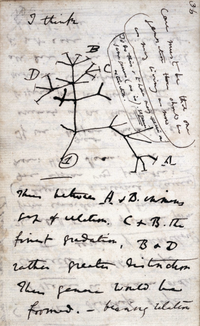
Photo from wikipedia
Abstract Engineered nanomaterials are rapidly becoming an essential component of modern technology. Thousands of tons of nanomaterials are manufactured, used, and subsequently released into the environment annually. While the presence… Click to show full abstract
Abstract Engineered nanomaterials are rapidly becoming an essential component of modern technology. Thousands of tons of nanomaterials are manufactured, used, and subsequently released into the environment annually. While the presence of these engineered nanomaterials in the environment has profound effects on various biological systems in the short term, little work has been done to understand their consequences over long, evolutionary timescales. The evolution of multicellularity is a critical step in the origin of complex life on Earth and a unique strategy for microorganisms to alleviate adverse environmental impacts, yet the selective pressures that favor the evolution of multicellular groups remain poorly understood. Here, we show that engineered nanomaterials, specifically copper oxide nanoparticles (CuO NPs), promote the evolution of undifferentiated multicellularity in Baker’s yeast (Saccharomyces cerevisiae strain Y55). Transcriptomic analysis suggests that multicellularity mitigates the negative effects of CuO NPs in yeast cells and shifts their metabolism from alcoholic fermentation towards aerobic respiration, potentially increasing resource efficiency and providing a fitness benefit during CuO NP exposure. Competition assays also confirm that the multicellular yeast possesses a fitness advantage when exposed to CuO NPs. Our results, therefore, demonstrate that nanoparticles can have profound and unexpected evolutionary consequences, underscoring the need for a more comprehensive understanding of the long-term biological impacts of nanomaterial pollution.
Journal Title: Nanotoxicology
Year Published: 2019
Link to full text (if available)
Share on Social Media: Sign Up to like & get
recommendations!